What makes a customer choose the same brand over and over again, even when there are cheaper or faster options out there?
In 2025, customer loyalty goes far beyond discounts and reward points—it’s built on trust, emotional connection, and consistently great experiences.
With rising competition and shifting expectations, brands that invest in loyalty are seeing real returns in retention, revenue, and reputation.
In this article, we’ve gathered the most important customer loyalty statistics to help you understand what drives loyalty today, what breaks it, and how leading companies stay ahead.
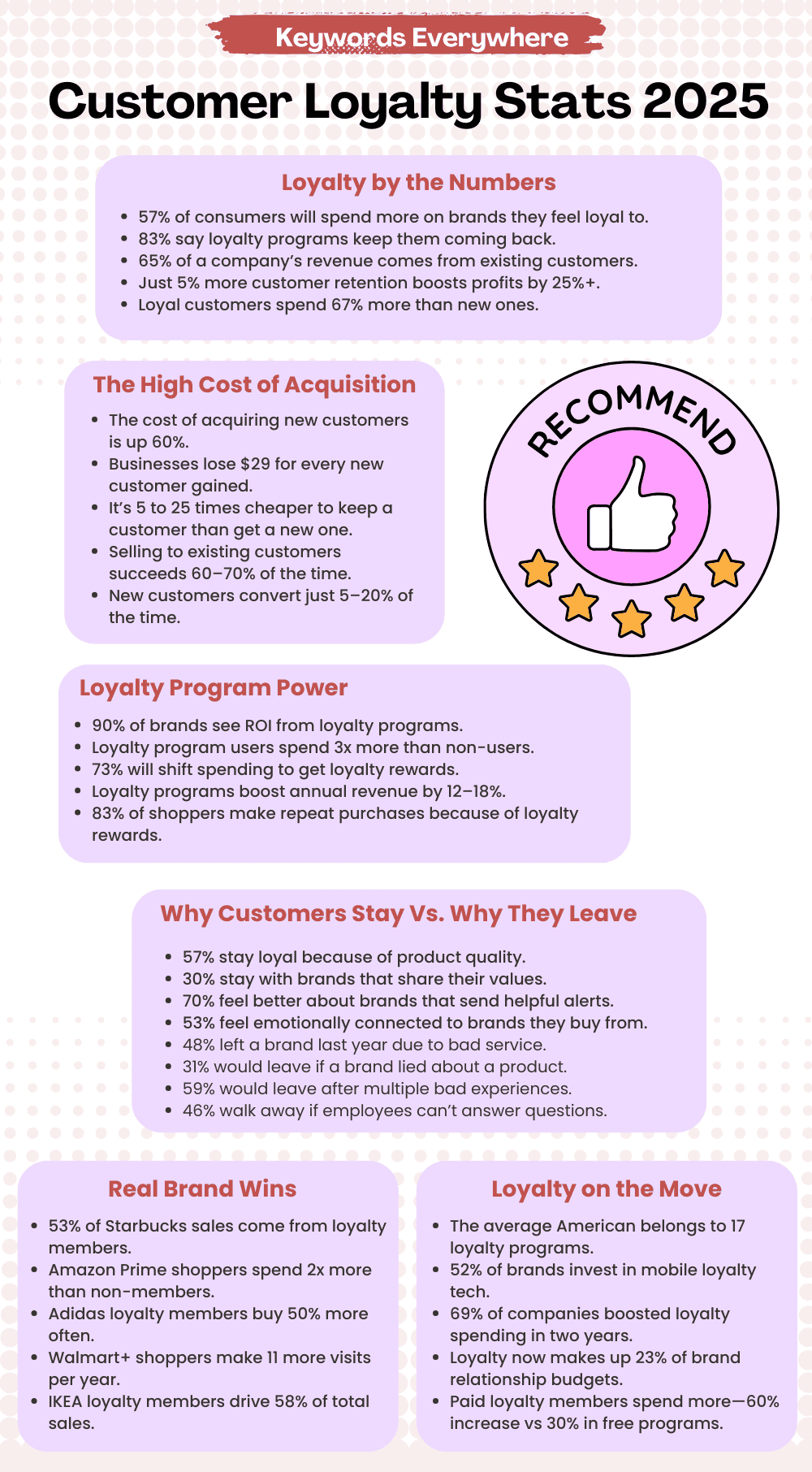
Top Customer Loyalty Statistics
Customer loyalty plays a much bigger role in business success than many people realize, and the numbers behind it clearly show just how much of an impact it has on revenue, retention, and long-term growth.
If you want a quick look at how loyalty shapes customer behavior in 2025, here are the stats that stand out the most and tell the full story right from the start.
1. 57% of consumers are willing to spend extra money on brands they feel loyal to, and nearly 9 out of 10 people say it takes at least three purchases before they start feeling truly loyal to a brand.
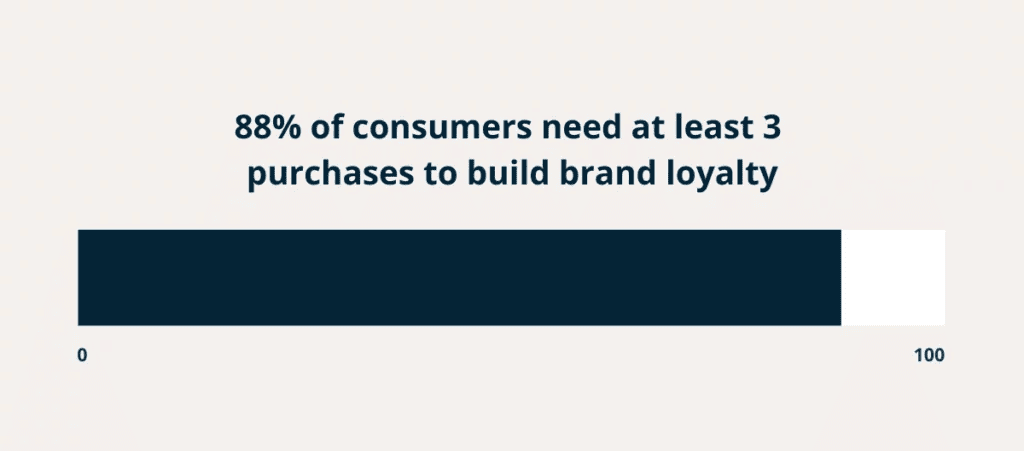
Purchases leads to brand loyalty over time
2. Over the past five years, the cost of getting new customers has increased by nearly 60%, and now businesses are losing an average of $29 for every new customer they bring in.
3. Just keeping 5% more of your current customers can lead to a big jump in profits—at least 25% more, which shows how powerful loyalty is.
4. Millennials are the most loyal group of all at 73%, while Gen Z follows a bit behind at 66%, and Gen X and Baby Boomers are tied at 68% when it comes to sticking with brands they like.
5. Loyalty programs really pay off for businesses, with 90% of companies seeing a good return on investment, and on average, they’re making nearly 5x what they spend.
6. 83% of people say that being part of a loyalty program makes them more likely to keep buying from the same brand repeatedly.
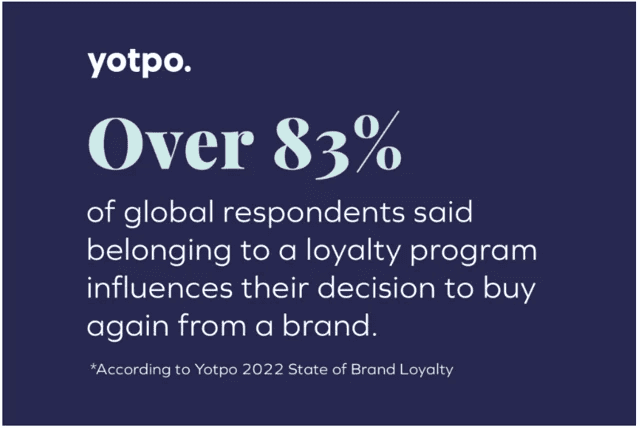
Loyalty program influences consumers to buy again
7. Trust loyalty, which comes from real connections instead of just discounts and perks, has grown by 26% since 2021 and now makes up 34% of all brand loyalty in 2024.
8. 30% of people say they stay loyal to brands that share their values, so it’s not just about price anymore—it’s also about what a brand stands for.
9. Companies that use personalized marketing, including things like custom video content, are seeing major benefits—loyalty goes up by 47%, and customer satisfaction improves by 36%.
10. The typical American is part of about 17 loyalty programs, which shows how common and important these programs have become in everyday shopping.
11. Starbucks Rewards is one of the best-known loyalty programs. According to Keywords Everywhere, over 49,000 people search for “Starbucks coffee rewards” every month and another 18,000 look for “Starbucks loyalty program” on Google.
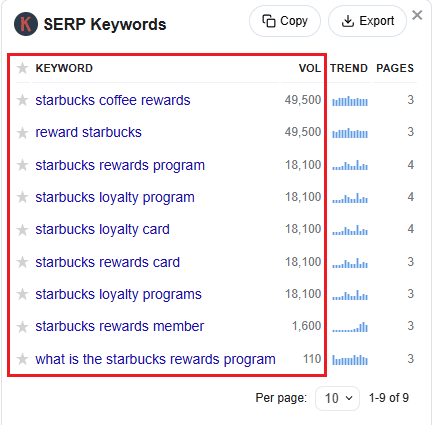
Why Customer Loyalty Matters
Keeping your customers happy and loyal isn’t just about getting them to return—it’s about building real relationships that lead to stronger trust, higher spending, and long-term value for your business.
The following customer loyalty stats reveal why it has become one of the most important things a company can focus on if it wants to grow and compete today.
12. 65% of a company’s revenue comes from people who have already bought from them before, which shows just how important repeat customers are for keeping a business strong.
13. It can cost 5 to 25 times more to bring in a brand-new customer than to keep one you already have, making customer retention a much smarter investment.
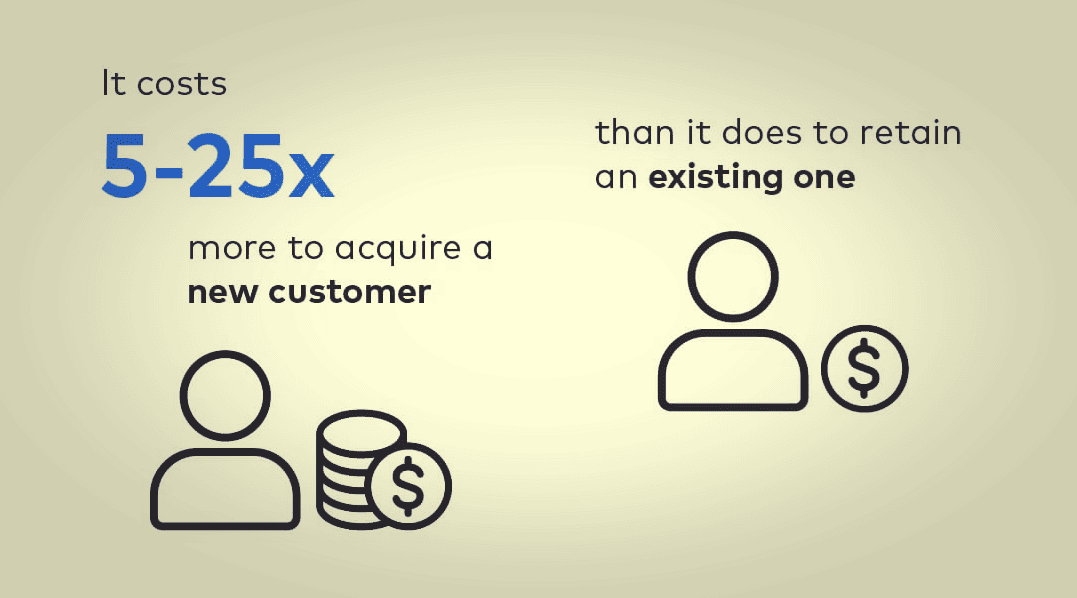
It’s more costly to acquire a new customer than to retain an existing one
14. You have a much better shot at making a sale to someone who’s already bought from you, with a success rate between 60% and 70%, compared to just 5% to 20% with someone new.
15. Almost 6 in 10 American consumers say that once they stick with a brand, they usually stay loyal to it for life, making loyalty one of the most powerful forces in business.
16. More than half of shoppers worldwide say customer service plays a “very important” role in which brands they choose and whether or not they stay loyal over time.
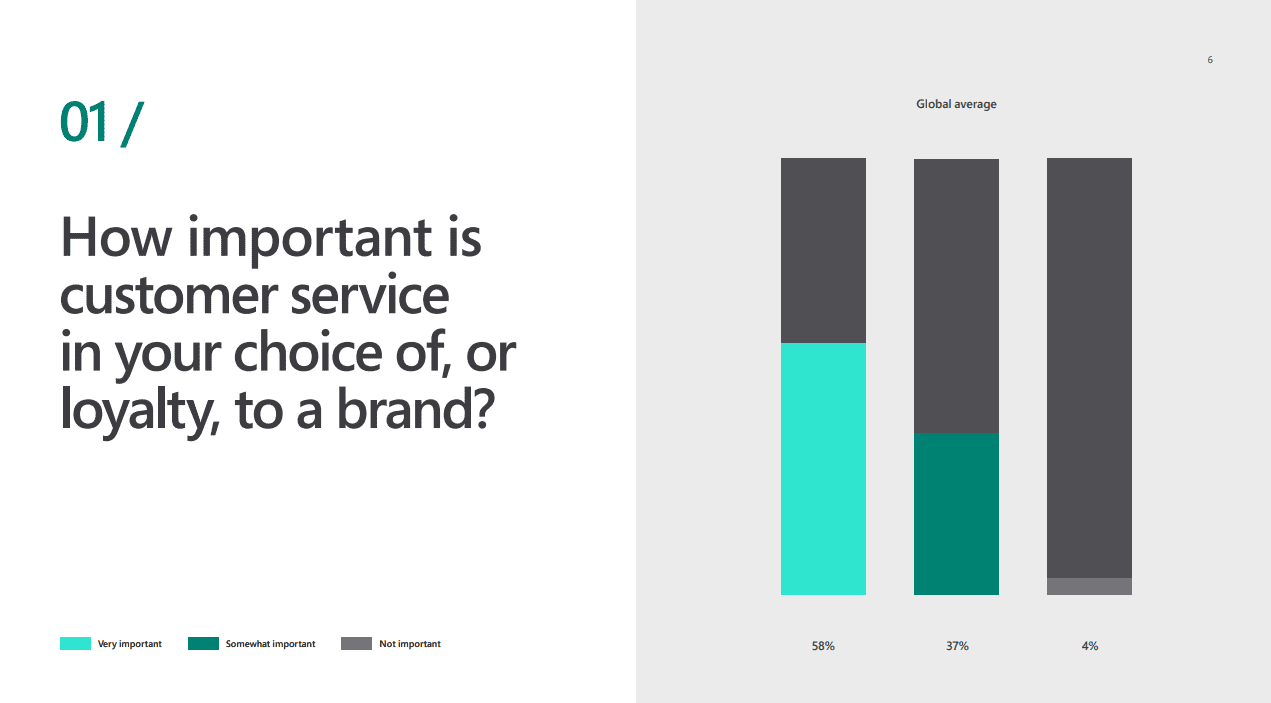
Importance of customer service
17. Good customer service matters because nearly half of people—48% to be exact—say they’ve stopped doing business with a brand in the past year because the service wasn’t good enough.
18. A large majority—77% of consumers—say they’ve stayed loyal to at least one brand for 10 years or even longer.
Factors That Influence Customer Loyalty
Loyalty doesn’t happen by chance—it’s the result of many little things that come together over time, like great service, consistent quality, emotional connection, and the overall ease of doing business.
Below are the customer loyalty stats that help explain what really drives customers to stick with a brand and what makes them feel like staying loyal is worth it.
19. 18% of people now use subscriptions to show their loyalty to a brand, which shows just how popular and common subscription-based services are becoming in today’s market.
20. Price is the biggest reason people stick with a brand, with 62% of global customers saying it matters most. In comparison, things like customer service came in close at 57% and product choices at 54%—and only 27% said things like personalization or special offers made a difference in keeping them loyal.
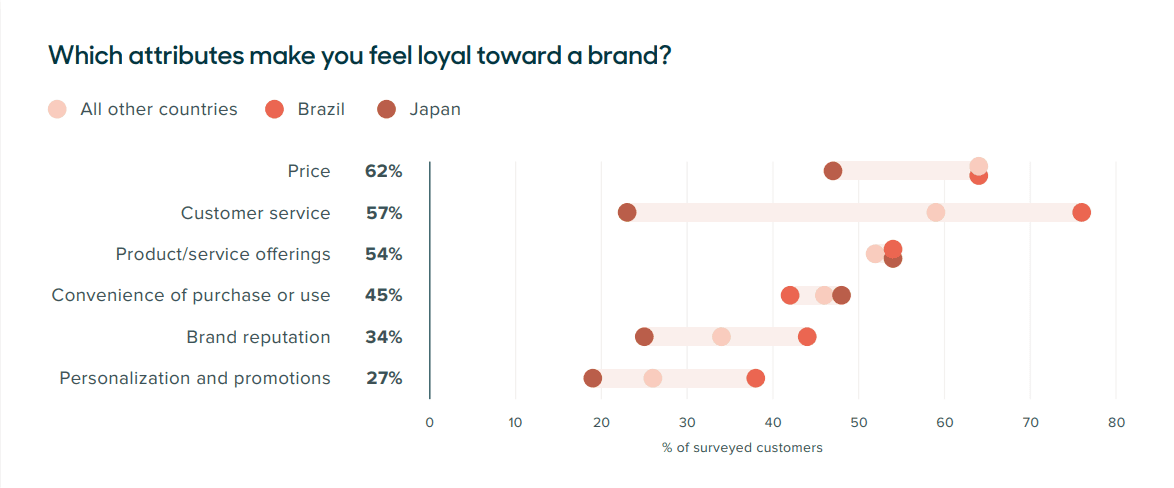
Price is the biggest reason customers stick to a brand
21. The number one reason people walk away from a brand is dishonesty, with 31% of Americans saying they would switch if they found out a company had lied about how well a product works.
22. 57% of consumers say that having high-quality products is the main reason they stay loyal to a brand, which proves that good products still matter most.
23. Around 34% of shoppers have stopped buying from a brand they used to love because of poor sustainability practices.
24. Nearly 1 in 3 people—30%—say their loyalty to a brand takes a hit if they feel the company is careless or irresponsible with their personal data.
25. 70% of customers say they feel more positively about brands that take the time to send helpful updates or alerts before a problem even comes up.
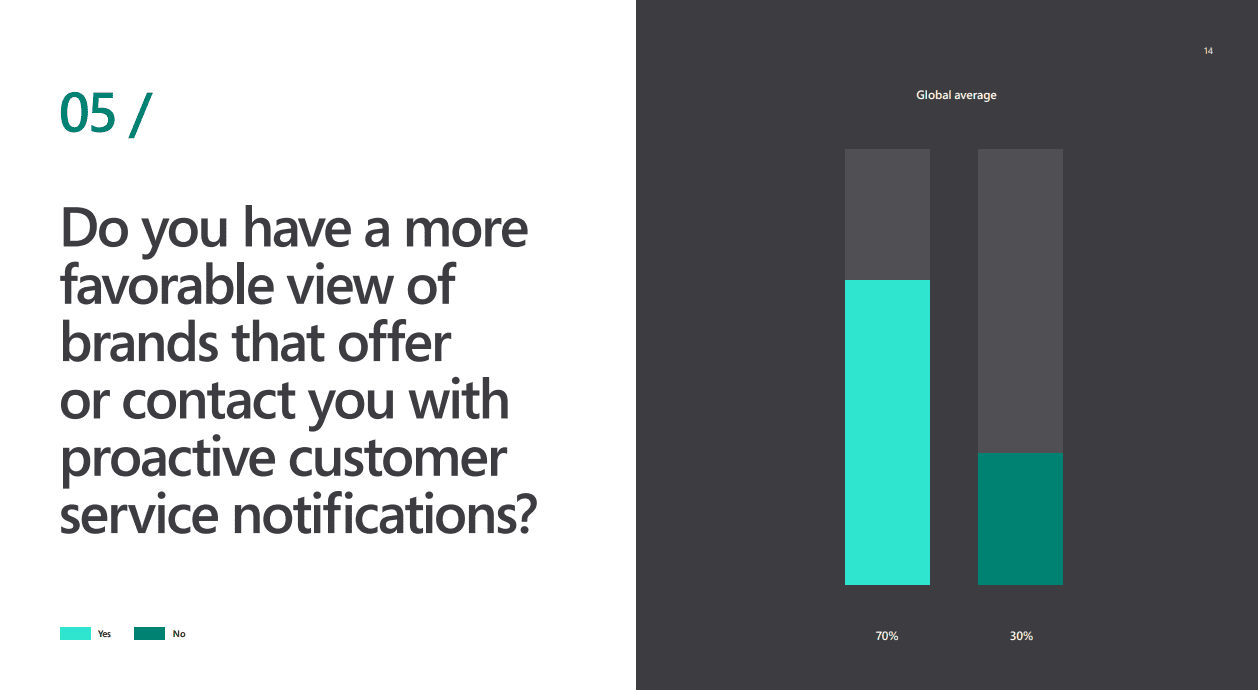
Consumers prefer proactive brands
26. About 59% of people say they view a brand more favorably when it responds to customer questions or complaints on social media.
The Role and Effectiveness of Loyalty Programs
Loyalty programs are one of the most common ways businesses try to keep customers coming back, but not every program works the same or delivers results that matter.
Here are the stats that show how loyalty programs are performing in 2025 and how smart companies are using them to build stronger brand relationships.
27. In 2024, there was a big jump in loyalty program use—up by 28% from the previous year, which is a 40% increase compared to how things looked in 2023.
28. 83% of shoppers say they’ve made repeat purchases because of being part of a loyalty program.
29. People who use their loyalty rewards spend more—on average, they spend over three times as much each year as members who don’t bother redeeming anything at all.
30. Loyalty program members help businesses grow faster, generating 12% to 18% more extra revenue each year than customers who aren’t in any loyalty program.
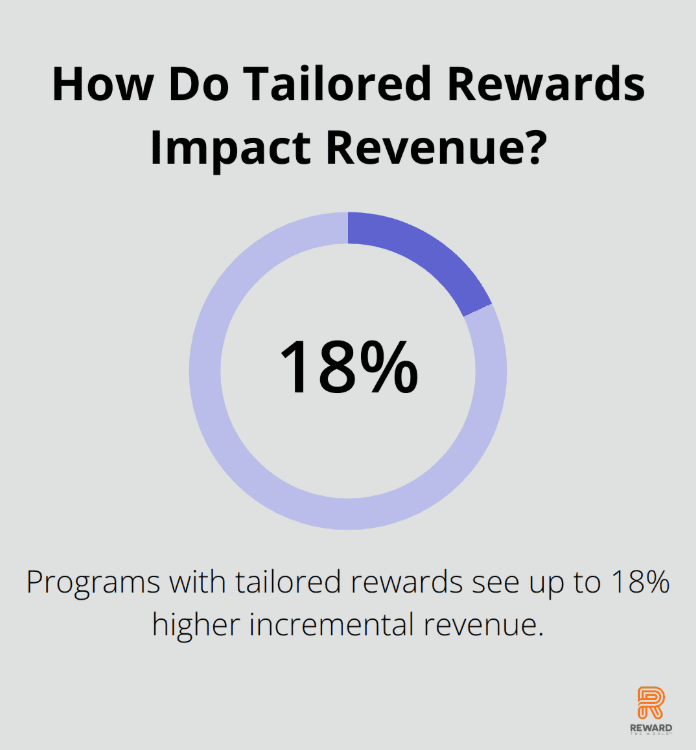
Loyalty programs impact revenue
31. The best loyalty programs out there are boosting yearly user revenue by 15% to 25%, which shows how effective a strong rewards system can be when done right.
32. 73% of consumers say they’re willing to shift how they spend just to get more out of their loyalty program benefits.
33. Many shoppers spend more with brands they feel connected to—37% do this through retail subscriptions, 28% through memberships, and 27% through loyalty programs, all because those programs make them feel like they’re getting something extra in return.
34. When consumers feel emotionally connected to one brand through a loyalty program or subscription, 95% say they’re more likely to keep buying from that brand.
35. Not everyone is happy with how loyalty programs work—45% of people don’t like how long it takes to earn rewards, 31% think earning rewards is just too hard, and 27% feel the rewards they get aren’t worth the effort.
36. People who pay for loyalty memberships tend to spend more, with 60% saying they increase their spending, while only 30% do the same when they’re in free loyalty programs.
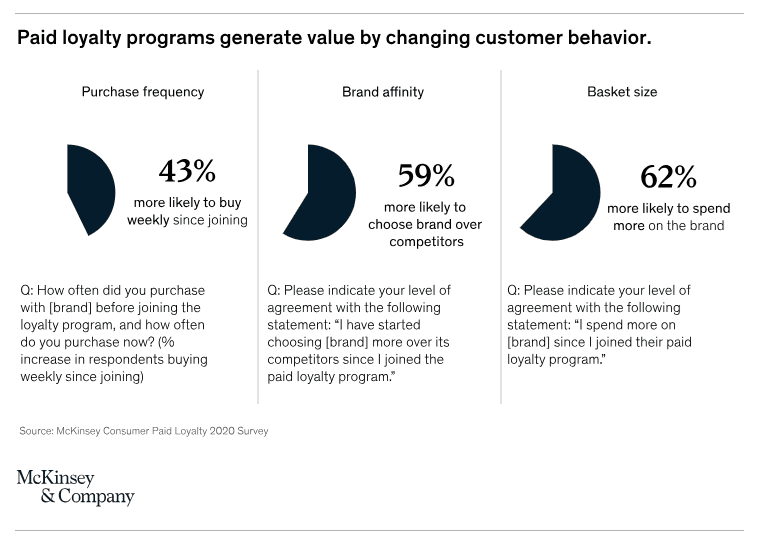
Paid loyalty programs create value by changing customer behavior
37. The main reason people say no to joining a loyalty program is the cost—70% of consumers say the membership fees hold them back the most.
38. Shoppers have high expectations with paid loyalty programs—58% of Americans expect free shipping with no minimums, 39% want same-day delivery, and 31% hope to find more options online than they would if they went into a physical store.
Customer Retention and Spending Behavior
When customers stick around, they usually spend more money and become more valuable to your business over time, which is why customer retention is so closely tied to long-term success.
The following customer loyalty stats reveal how loyal buyers behave when spending and why keeping the ones you already have is often better than constantly chasing new ones.
39. 82% of business leaders agree that it costs way less to keep a customer returning than it does to go out and find someone brand new.
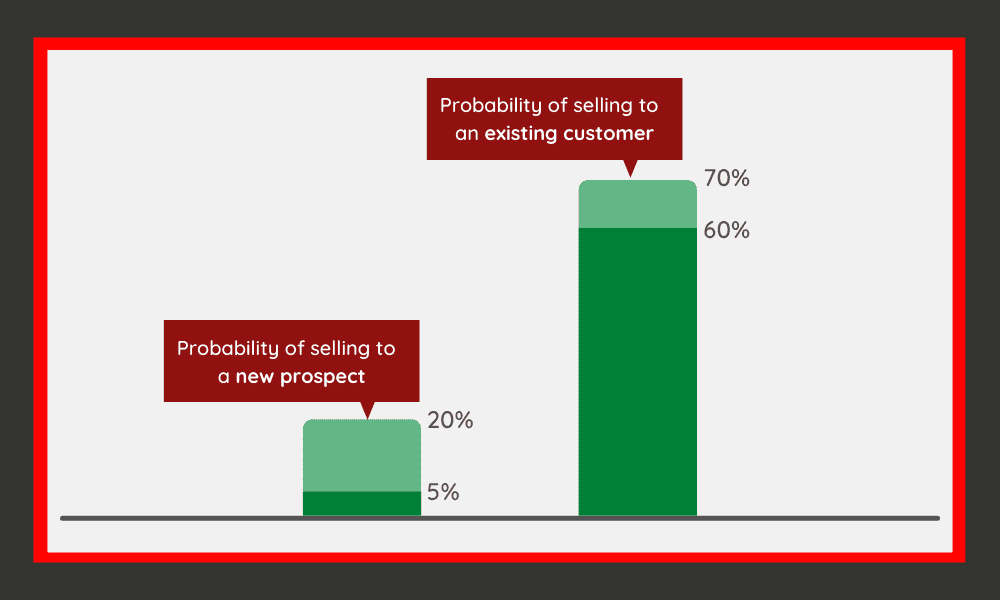
Customer acquisition vs customer retention
40. When it comes to sales, your odds are much better with people who’ve already bought from you—your chances of selling to a new customer sit at just 5% to 20%, but that jumps to 60% or 70% with returning ones.
41. Poor customer retention is a costly issue in the U.S., where businesses lose about $136.8 billion every year just because they can’t keep their customers around.
42. People who already shop with a brand tend to spend a lot more—on average, they spend 67% more than brand-new customers.
43. Loyalty management takes up a big chunk of global brand budgets, making up 23% of what they spend on building and maintaining customer relationships.
44. The top 10% of customers are worth paying attention to because they spend three times more than the other 90%.
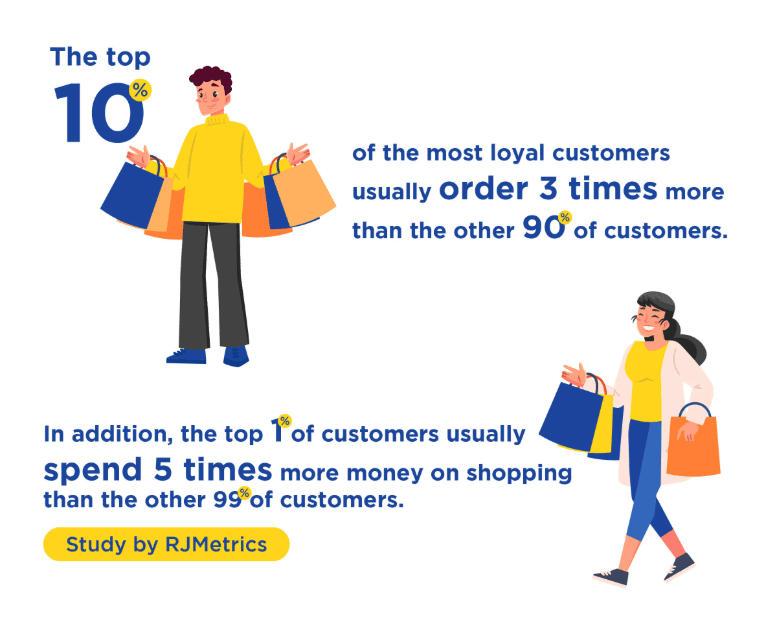
Loyal customers spend more than other customers
45. Brands aren’t shy about spending on loyalty—each year, they pour more than $75 billion into loyalty management programs to keep their best customers engaged and coming back.
46. A customer who has already made multiple purchases is nine times more likely to buy again than someone shopping for the first time.
47. 52% of global brands are now investing in mobile tech, like digital wallets, to support their loyalty strategies and make rewards easier to access on the go.
48. Nearly 7 in 10 brand leaders—69% to be exact—say they’ve increased how much they’re spending on loyalty over the past two years.
Customer Engagement and Experience
People are more likely to stay loyal to a brand when they feel heard, valued, and well taken care of, which is why the customer experience has become such a big part of loyalty strategies today.
Below are the customer loyalty stats that show just how powerful a smooth, engaging, and personalized experience can be when it comes to earning long-term trust.
49. 53% of consumers say they feel the most emotionally connected to the brands they buy from.
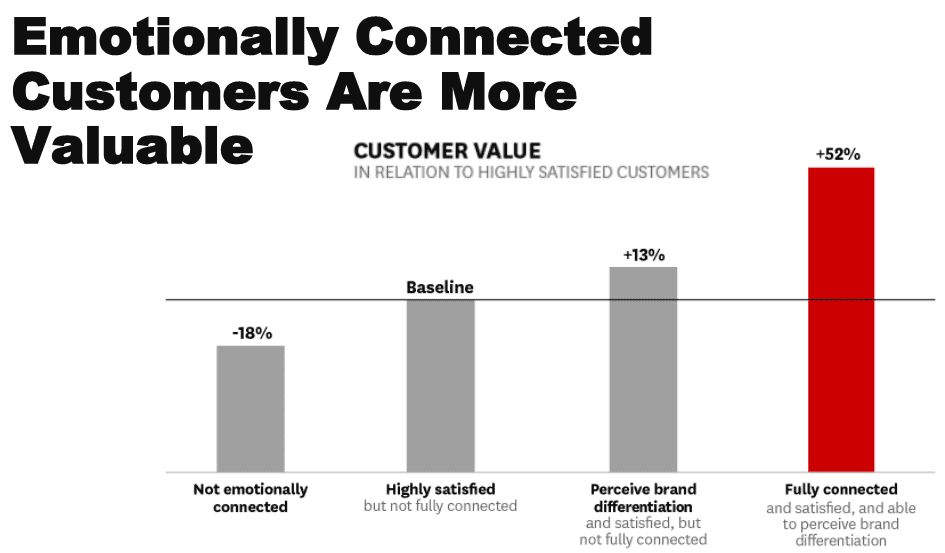
Emotionally connected consumers are more valuable
50. 91% of customers say they’re more likely to make another purchase after a great service experience.
51. 80% of customers say that a company’s experience is just as important as the product or service itself.
52. Among younger adults aged 25 to 34, 67% believe that when brands offer their products as services, those brands do a better job of understanding what customers need.
53. That same age group feels strongly about experience too—64% of them say that when companies offer products as services, it usually leads to a better overall experience.
54. Many young consumers want more from brands even after the sale is done—68% of people aged 25 to 34 say they feel more connected to companies that provide helpful services beyond just the purchase.
55. 68% of brands say they believe that using “as-a-service” models helps them deliver better customer experiences that are more personalized and flexible.
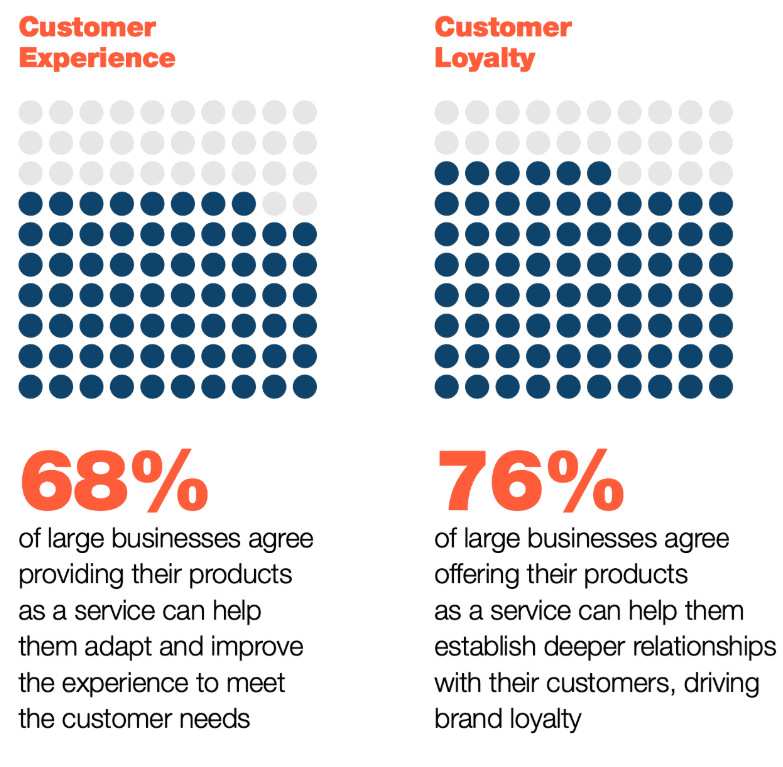
How brands can improve customer experience
56. 58% of those between 16 and 34 say they enjoy it when companies make personal recommendations based on their own likes and preferences.
57. Still, not everyone is convinced that companies have their best interests in mind—37% of people worldwide think that many businesses care more about making money than giving customers a great experience.
What Breaks Customer Loyalty
Even if someone has been loyal to a brand for years, certain things can push them away quickly, especially when their expectations aren’t met or their trust is broken.
What are the things that drive customers away?
Here are the customer loyalty stats that show what causes customers to lose faith in a company and what mistakes can lead even the most loyal people to walk away.
58. Even if someone loves a brand, it only takes one really bad experience to walk away—about 1 in 3 customers say that’s enough for them to leave for good.
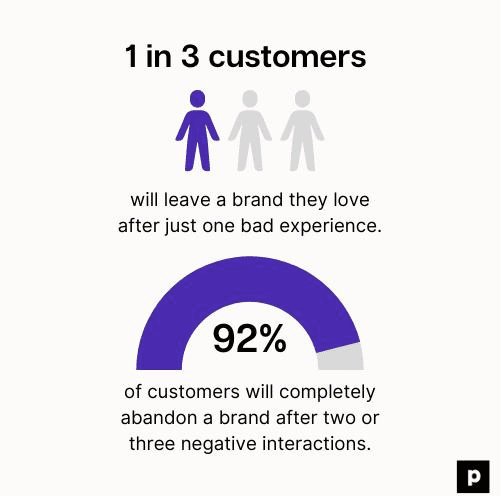
Impact of negative experience on business
59. 59% of U.S. customers say if they have a few bad interactions with a company they once loved, they’ll eventually give up on it completely.
60. 50% of all customers won’t even bother with a business’s website if it’s not mobile-friendly, so even if they like the brand, they’ll move on if the site doesn’t work well on their phones.
61. 51% of shoppers say that if they have to pay to return something, they probably won’t buy it in the first place, which shows how much return policies matter.
62. Nearly half of consumers—46%—say they’ll stop buying from a brand if the employees don’t seem to know what they’re talking about because helpful service still makes a big difference.
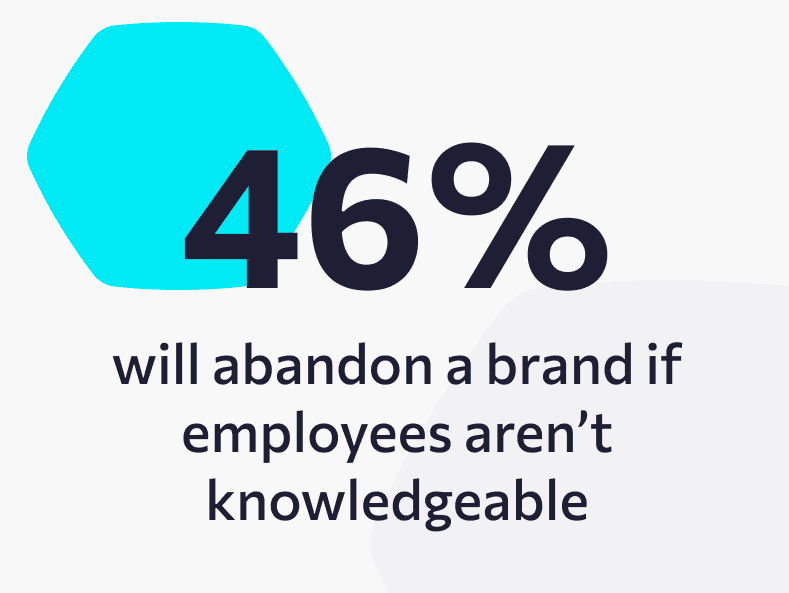
Trained and educated staff improves customer experience
Real-World Loyalty Program Success Stories
Some companies are doing loyalty right, using smart rewards, great timing, and personal touches to turn casual buyers into long-term fans who keep coming back.
The following examples and stats show real-life success stories where loyalty programs made a real difference, proving that when done well, these programs can create results that go far beyond discounts.
63. Amazon Prime members tend to shop a lot more, spending more than twice as much as customers who don’t have a membership.
64. Walmart+ members aren’t just spending more per trip—around $79 per online visit compared to $62 for non-members—they’re also shopping more often, with 11 extra visits each year on average.
65. Adidas adiClub members buy from the brand 50% more often than non-members do, and their total value over time is twice as high.
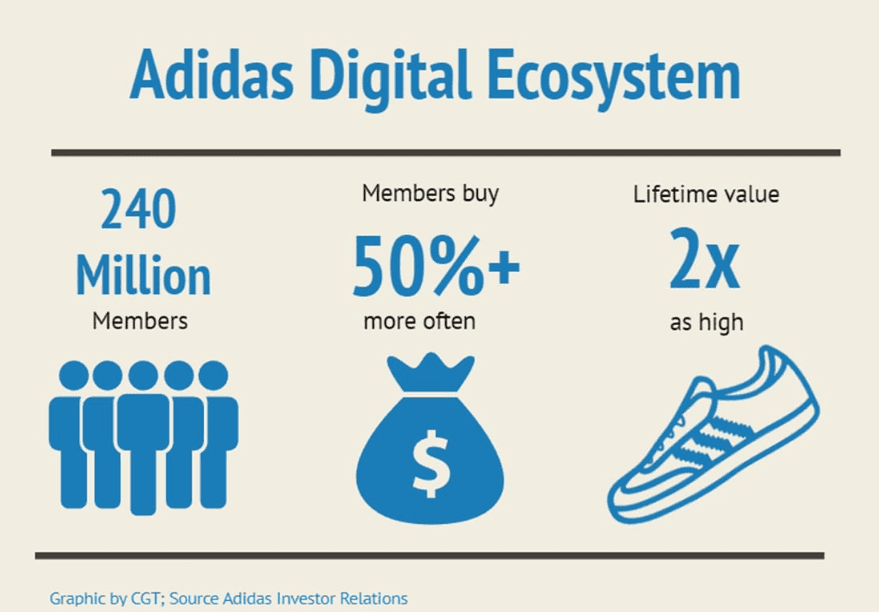
Adidas loyalty program success
66. Starbucks Rewards is doing its job because more than half—53%—of all money spent in the U.S. Starbucks stores now comes from customers who are part of the program.
67. Lululemon’s loyalty program pulled in a huge nine million members in just five months, and more than 30% of them used at least one benefit during that short period.
68. H&M saw their loyalty program grow a massive 71% in 2021, reaching over 120 million members.
69. After IKEA upgraded its loyalty program, members started making up more than half of all sales—58% to be exact—which shows how much people appreciate being part of something rewarding.
Conclusion
As these stats make clear, customer loyalty isn’t just about offering good products anymore — it’s about creating a full experience that makes people want to stick around.
Today’s consumers expect more from brands, from strong customer service and fair pricing to values that match their own.
Loyalty programs, personalization, and mobile-first strategies are becoming must-haves rather than nice-to-haves because when people feel seen and appreciated, they tend to return.
Moving forward, the brands that win will be the ones that not only deliver on what they promise but also adapt quickly to what their customers truly care about.


